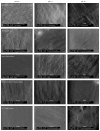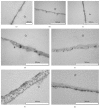Influence of Calcium Phosphate and Apatite Containing Products on Enamel Erosion
- PMID: 27430013
- PMCID: PMC4939184
- DOI: 10.1155/2016/7959273
Influence of Calcium Phosphate and Apatite Containing Products on Enamel Erosion
Abstract
For the purpose of erosion prevention the present study aimed to compare the efficacy of two biomimetic products and a fluoride solution to optimize the protective properties of the pellicle. After 1 min of in situ pellicle formation on bovine enamel slabs, 8 subjects adopted CPP-ACP (GC Tooth Mousse), a mouthwash with hydroxyapatite microclusters (Biorepair), or a fluoride based mouthwash (elmex Kariesschutz) for 1 min each. Afterwards, samples were exposed in the oral cavity for 28 min. Native enamel slabs and slabs exposed to the oral cavity for 30 min without any rinse served as controls. After oral exposure, slabs were incubated in HCl (pH values 2, 2.3, and 3) for 120 s and kinetics of calcium and phosphate release were measured photometrically; representative samples were evaluated by SEM and TEM. The physiological pellicle reduced demineralization at all pH values; the protective effect was enhanced by fluoride. The biomimetic materials also reduced ion release but their effect was less pronounced. SEM indicated no layer formation after use of the different products. However, TEM confirmed the potential accumulation of mineral components at the pellicle surface. The tested products improve the protective properties of the in situ pellicle but not as effectively as fluorides.
Figures





Similar articles
-
Effect of Tannic Acid on the Protective Properties of the in situ Formed Pellicle.Caries Res. 2017;51(1):34-45. doi: 10.1159/000451036. Epub 2016 Dec 14. Caries Res. 2017. PMID: 27960156
-
Application of Plant Extracts for the Prevention of Dental Erosion: An in situ/in vitro Study.Caries Res. 2015;49(5):477-87. doi: 10.1159/000431294. Epub 2015 Jul 29. Caries Res. 2015. PMID: 26228871
-
Effect of safflower oil on the protective properties of the in situ formed salivary pellicle.Caries Res. 2012;46(5):496-506. doi: 10.1159/000339924. Epub 2012 Jul 14. Caries Res. 2012. PMID: 22813924
-
Molecular and Pharmaceutical Aspects of Novel Methods and Materials for the Prevention of Tooth Structure Loss.Curr Pharm Biotechnol. 2017;18(1):45-51. doi: 10.2174/1389201017666161207163851. Curr Pharm Biotechnol. 2017. PMID: 27928950 Review.
-
The future of fluorides and other protective agents in erosion prevention.Caries Res. 2015;49 Suppl 1:18-29. doi: 10.1159/000380886. Epub 2015 Apr 13. Caries Res. 2015. PMID: 25871415 Review.
Cited by
-
Adhesion of Hydroxyapatite Nanoparticles to Dental Materials under Oral Conditions.Scanning. 2020 May 5;2020:6065739. doi: 10.1155/2020/6065739. eCollection 2020. Scanning. 2020. PMID: 32454927 Free PMC article.
-
Impact of customary fluoride rinsing solutions on the pellicle's protective properties and bioadhesion in situ.Sci Rep. 2017 Nov 29;7(1):16584. doi: 10.1038/s41598-017-16677-8. Sci Rep. 2017. PMID: 29185495 Free PMC article.
-
Effect of fluoride mouthrinses and stannous ions on the erosion protective properties of the in situ pellicle.Sci Rep. 2019 Mar 29;9(1):5336. doi: 10.1038/s41598-019-41736-7. Sci Rep. 2019. PMID: 30926846 Free PMC article.
-
Dental Applications of Ion-Substituted Hydroxyapatite: A Review of the Literature.Dent J (Basel). 2024 Sep 25;12(10):304. doi: 10.3390/dj12100304. Dent J (Basel). 2024. PMID: 39452432 Free PMC article. Review.
-
The composition of the dental pellicle: an updated literature review.Front Oral Health. 2023 Oct 12;4:1260442. doi: 10.3389/froh.2023.1260442. eCollection 2023. Front Oral Health. 2023. PMID: 37899941 Free PMC article. Review.
References
Publication types
MeSH terms
Substances
LinkOut - more resources
Full Text Sources
Other Literature Sources
Miscellaneous

